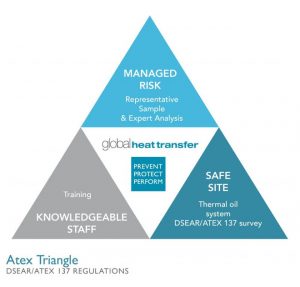DSEAR & UKEX (formally ATEX) regulations for thermal fluid management
Any company that uses a heat transfer system containing thermal fluid must proactively maintain their thermal fluid system to reduce the risks associated with explosive atmospheres.
Explosive atmospheres in the workplace can be caused by flammable gases, mists or vapours, or by combustible dust. If these dangerous substances mix with air under atmospheric conditions, they can ignite and cause significant damage.
When mineral or synthetic oils are heated to very high temperatures for extended periods of time, the fluid will begin to degrade if it’s not monitored and managed properly.
Fluid degradation can cause a fluid’s flash point, the minimum temperature at which the fluid’s vapours will ignite in the presence of a source of ignition, to decrease. If fluid condition continues to deteriorate and the system is not regularly maintained, it can increase the risk of fire.
For example, if degraded fluid is leaking from the system, the hydrocarbons produced during degradation are released as vapours, known as volatile light ends. A leak might also produce a spray of fine material — the greater the pressure, the higher the risk.
The Dangerous Substances and Explosive Atmospheres Regulations (DSEAR) of 2002 and the Explosive Atmosphere Directive (ATEX 137) are mandatory requirements for minimising safety risks and protecting workers from fire and explosion where flammable or explosive materials are present.
This health and safety legislation sets out the legal requirement for thermal fluid systems and representative fluid analysis and requires that employers provide a safe working environment. Employers have a legal obligation to not only comply with this legislation but to prepare and maintain documentary evidence.
The Dangerous Substances and Explosive Atmospheres Regulations 2002 (DSEAR) are concerned with protection against risks from fire, explosion and similar events caused by the presence of dangerous substances.
Under the legislation, employers must:
- Carry out assessment of the fire and explosion risks of any work activities involving dangerous substances, including thermal oils and synthetics.
- Implement measures to eliminate, or reduce as far as is reasonably practicable, the identified fire and explosion risks. For heat transfer fluid this means monitoring the flash point by collecting a representative sample from a hot, closed system and to sustain and/or restore flash points by venting procedures or dilutions where the former is not an option.
- Apply measures, so far as is reasonably practicable, to control risks and to mitigate the detrimental effects of a fire or explosion and maintain security of the system to prevent leaks and remove sources of ignition.
- Provide equipment and procedures to deal with accidents and emergencies
- Provide employees with thermal fluid management training that ensures engineers are aware of the need to sample correctly to accurately monitor and manage flash points
Directive 99/92/EC, also known as ATEX 137 or ATEX Workplace Directive, is a European Directive that provides guidance on controlling explosive atmospheres. It outlines the minimum requirements for improving health and safety in a facility that uses heat transfer fluids or other materials that create an explosive atmosphere.
The legislation stipulates that facilities where explosive atmospheres may occur must:
- Classify the hazardous and non-hazardous areas of the workplace
- Classify the hazardous places into zones of the basis of frequency and duration of an explosive atmosphere and where necessary, mark these areas with signs.
- Ensure that equipment in classified zones satisfies the requirements of Equipment and Protective Systems Intended for use in Potentially Explosive Atmospheres Regulations 1996
- Ensure that trained staff carry out the tasks required to ensure the workplace meets legislation. This would usually be the health and safety manager/director, engineering manager or operations manager/director.

Manufacturers can ensure regulatory compliance by following the ATEX triangle, which outlines three key areas:
- Managed risk — Representative sampling and expert analysis to monitor and slow fluid degradation
- Safe site — Regular system maintenance and surveys in line with DSEAR/ATEX 137
- Knowledgeable staff — Training on thermal fluid maintenance, safe handling and storage of fluids and system surveying can help make sure that employees are aware of what is necessary for compliance.
New thermal fluid does not go from being fit for use to needing replacement overnight. There is a grey area where fluids can be managed against the degradation curve. Degradation is steady if a system is operated properly, but as the fluid approaches the end of its practical working life, the gradual curve drops off very sharply. This sudden change in the chemistry of thermal fluids is one of the reasons why regular and preventative maintenance is so important so manufacturers can maintain an earlier position in the degradation curve and reduce the risk of unplanned downtime.
Performing regular sampling and heat transfer fluid analysis can reduce the risk of explosive atmospheres in the workplace. Manufacturers can collect fluid samples, analyse the condition, and use the results to track the lifespan of the fluid, so that they can intervene before degradation lowers the flash point to a dangerous level.
Implementing a preventative maintenance programme for thermal fluid management will help you comply with the legislative requirements. For example, as part of Global Heat Transfer’s Thermocare, our engineering experts will suggest, plan, and implement maintenance schedules, deliver training and provide the documentation required to comply with legislations.
Global Heat Transfer provides three types of maintenance plan — essential, optimum and ultimate — depending on what support a company needs.
Want to improve fluid condition and comply with regulations?
For more information about DSEAR/ATEX compliance, call us on +44 (0)1785 760 555 or complete our contact form to book a sample analysis.
For advice on regulatory compliance in other countries, get in touch with our team in the US, Asia and more locations by visiting our contact page.

